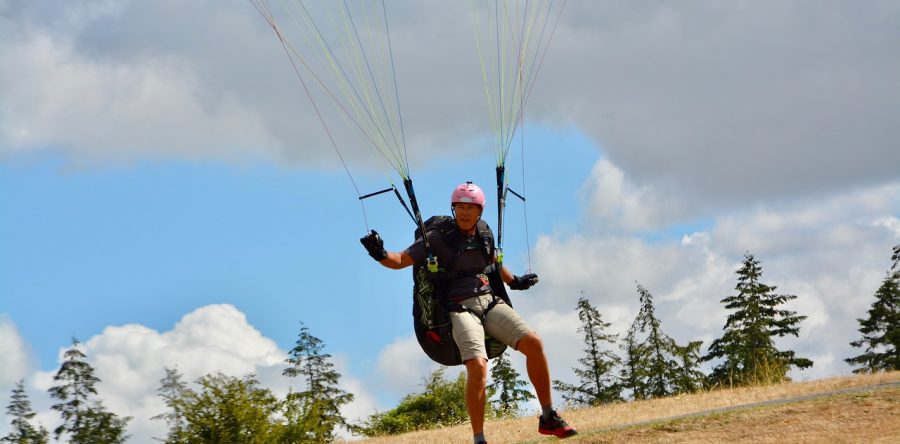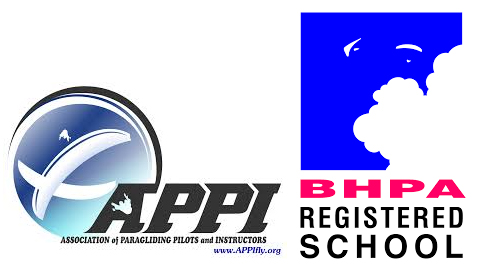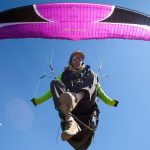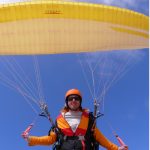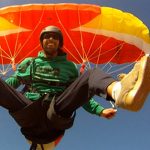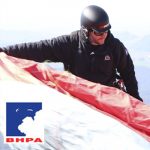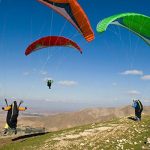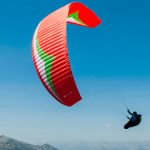How to approach to the landing field in paragliding
Let's now consider the last stage of any flight: the landing.
The landing involves two phases: the approach pattern, or simply called the approach, and the final, which is the last leg of the approach before landing. An approach pattern allows you to better position yourself in relation to the landing target by gradually losing altitude.
The approach pattern is part of the flight plan that your instructor sets up before launching. During your paragliding course, it is never improvised; before taking flight you should visit the landing field to get an idea of its layout and specific features.
The approach to the landing field technique
There are three indispensable rules for any approach: First, figure out the direction of the wind on the ground, use the windsock to orient yourself so that the last leg of your pattern the final is facing the wind. Second, stay outside of the field, near its edge and keep your eye on the landing target. Third, never turn your back on the field; this will prevent you from losing sight of the landing target.
S-turn landing approach
An S turn landing approach allows the pilot to lose altitude by making a series of s turns within a cone of safe airspace. The size of the SS decreases have the pilot loses altitude by tracing smaller and smaller asses the pilot loses enough altitude and lines himself up with the target for the final approach. When using this technique turns need to be smooth and steady, make sure you avoid steep turns near the ground.
Figure 8 landing approach
A series of figure 8 terms are used to lose altitude. The eight get smaller and smaller so that the pilot can lose altitude and get in line with the landing field before his final turn. If
the pilot overshoots the landing he can trace different sized figure eights to reposition himself.
U-turn landing approach
This type of approach is technically challenging: The pilot needs to know how fast his speed and altitude are changing in relation to the ground. This approach is ideal for a landing on a field surrounded by obstacles. The U or standard aircraft approach has two
phases. This approach is also called constant aspect approach.
The first phase, without taking his eyes off the target, the pilot approaches the landing field along one of its sides, though unusual the pilot will be flying downwind during this phase he needs to take this into account when assessing his airspeed. The second phase, the base leg; by looking at the target the pilot will determine the best moment to make his first turn. The rest of the approach depends on this turn; the pilot needs to figure out how
much distance he has left to cover as well as the altitude he'll need before making the final turn.
The final approach to land
Whatever approach technique you choose to use you should always end up with a long final. There are two keys to making a successful landing: the first is the paragliding stability during the final, as the pilot gets close to the ground he must keep the wing level and steady, and the second the speed a long final allows the pilot to increase his speed and build up energy that he can convert into a final flare.
The flare
The flare will eliminate his vertical and horizontal speed and make a soft touchdown possible. Let's break down the phases of a landing: after entering the final approach, the pilot keeps his eyes fixed on the target with his arms up in order to increase the speed of his wing. Remember however to slightly apply tension on the brakes when turbulence is
a present. Only now can the pilot get into an upright position, he's ready to touch down at any moment. In order to land safely, the pilot must reduce his airspeed and ground speed to a minimum. This is done by applying both brakes fully. This is called the flare.
The flare is initiated two to three metres above the ground. This switch makes the wing pull out and produces a flare right before touchdown.
A paragliding instructor will tell you when to make the switch by radio during your beginner's paragliding course. Be careful, each landing is different; the amplitude and the timing of this switch are determined by the wind speed with experience it'll become second nature and you'll discover the joy and comforts of making smooth touchdowns.
This post is a transcription of the video "Learn to Fly" (Kitchen Productions)

